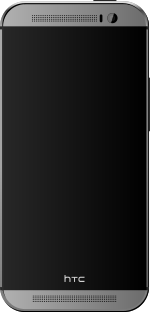 | |
| Manufacturer | HTC |
|---|---|
| Type | Touchscreen smartphone |
| Slogan | See It. Feel It. |
| Series | HTC One |
| First released | March 25, 2014 |
| Availability by region | March 25, 2014 |
| Predecessor | HTC One (M7) |
| Successor | HTC One M9 |
| Related | HTC One Mini 2 |
| Form factor | Slate |
| Dimensions | 146.4 mm (5.76 in) H 70.6 mm (2.78 in) W 9.4 mm (0.37 in) D[1] |
| Weight | 160 g (5.6 oz) |
| Operating system | Original: Android KitKat Current: Android 6.0 "Marshmallow" |
| System-on-chip | Qualcomm Snapdragon 801 |
| CPU | 2.26 GHz quad-core (MSM8974ABv3) 2.45 GHz quad-core (MSM8974ACv3)[2] |
| GPU | Adreno 330 550/578 MHz |
| Memory | 2 GB LPDDR3 RAM |
| Storage | 16 or 32 GB flash |
| Removable storage | microSD up to 128 GB |
| SIM | MicroSIM |
| Battery | 2,600 mAh Li-po battery |
| Rear camera | 4.0-megapixel; 2.0 μm camera with autofocus, UltraPixel BSI image sensor, dual-LED dual tone flash, F2.0 aperture, 28 mm lens, continuous shooting, 2.0-megapixel depth of field sensor. |
| Front camera | 5.0-megapixel, 2.0 μm camera, BSI image sensor |
| Display | 5.0 in (130 mm) Super LCD 3 with RGB matrix 1920 x 1080 pixels (16:9 Aspect ratio) (441 ppi) Corning Gorilla Glass 3.0 |
| Connectivity | List
|
| Data inputs | List |
| Codename | M8 |
| Website | http://www.htc.com/www/smartphones/htc-one-m8/ |
The HTC One (M8) (also marketed as the all-new HTC One)[3] is an Android or Windows smartphone manufactured and marketed by HTC. Following a number of leaks that occurred during the months prior, the device was officially unveiled in a press conference on March 25, 2014, and released the same day by Verizon Wireless at retail, and by other Canadian and United States carriers for online orders prior to its wider retail availability in mid-April.
The device retains a similar design to the HTC One (M7), its predecessor in the HTC One series, but features a larger, rounded chassis incorporating a 5-inch 1080p display, a quad-core Qualcomm Snapdragon 801 processor, a depth of field sensor which can be used to individually refocus and apply various effects to the foreground and background elements of photos taken with the device's camera, a higher resolution front camera, improvements to the device's front-facing stereo speakers, expandable storage, new gesture functionality, and a refreshed version of HTC's Sense software. In August 2014, HTC unveiled a software variant of the device running Windows Phone 8.1 instead of Android, aiming to adapt the operating system's experience to the device "[without] any compromises."[4]
The device received mostly positive reviews, with particular praise devoted to the design improvements within its hardware and software, and its upgraded internals in comparison to the One (M7). However, some reviewers criticized certain aspects of the device, such as its large bezels, the lack of significant improvements to the main camera's image quality, removal of optical image stabilization, and the inconsistent quality of the effects enabled by the depth sensor.
- ^ Dolcourt, Jessica. "HTC One M8 specs versus Samsung Galaxy S5, iPhone 5S". CNET. CBS Interactive. Archived from the original on 25 March 2014. Retrieved 25 March 2014.
- ^ Ho, Joshua (25 March 2014). "HTC launches the One (M8)". AnandTech. Archived from the original on 27 March 2014. Retrieved 27 March 2014.
- ^ Holly, Russell (February 26, 2014). "HTC teases the "All New HTC One" in new promo video". Geek.com. Archived from the original on 2019-04-16. Retrieved 2019-04-17.
- ^ Cite error: The named reference
cnet-m8winridewas invoked but never defined (see the help page).